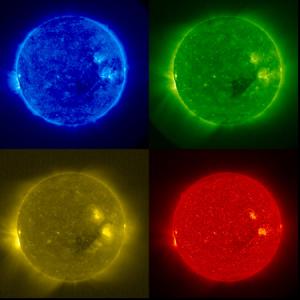Sun's Hot Atmosphere

A close up of loops in a magnetic active region.
These loops, observed by STEREO's SECCHI/EUVI telescope, are at a million degrees C. This powerful active region, AR903, observed here on Dec. 4, produced a series of intense flares over the next few days. (Credit: NASA)
_______________________________________________________
Solar Satellite's First Images Show Sun's Super-hot Atmosphere
NASA's twin Solar Terrestrial Relations Observatories (STEREO) first images of the sun give a view into the sun's mounting activity.
"STEREO is the first mission using the moon's gravity to redirect multiple spacecraft, launched aboard a single rocket, to their respective orbits," said Ron Denissen, APL STEREO project manager. On Dec. 15, 2006, mission operations personnel at the laboratory used lunar gravitational swingbys to alter the spacecraft orbits, redirecting the "A" observatory to its orbit "ahead" of Earth. The "B" observatory swung past the moon a second time on Jan. 21, redirecting it to an orbit "behind" Earth.
The two will orbit the sun from this perspective, separating from each other by about 45 degrees per year. Scientists expect the two to be in position to produce 3-D images by April 2007.
"Our ultimate goal is seeing solar flares and coronal mass ejections in 3-D to better understand their origin, evolution and determine whether or not they're a threat to Earth," said Russell Howard, principal investigator for SECCHI, the imaging instrument suite aboard both observatories. Howard and his staff are a part of the Naval Research Laboratory (NRL) in Washington, DC.

Artist's concept showing a coronal mass ejection (CME) sweeping past STEREO. (Image credit: NASA)
_______________________________________________________
Coronal mass ejections, - giant clouds of plasma shot out into space by the sun and X-ray emitting solar flares are the largest explosions in the solar system and can pack the force of a billion megaton nuclear bombs. They are caused by the buildup and sudden release of magnetic stress in the solar atmosphere above the turbulent active regions we see as sunspots.
When directed at Earth, CMEs can produce spectacular aurora and disrupt satellites, radio communications and power systems. Energetic particles associated with these solar eruptions permeate the entire solar system and may be hazardous to spacecraft and astronauts.
“An integral part of exploration, heliophysics is the system science that unites all of the linked phenomena in the region of the cosmos influenced by a magnetically variable star like our sun,” said Madhulika Guhathakurta, NASA STEREO program scientist at NASA Headquarters, Washington. The STEREO mission represents the most significant upgrade and expansion to this system science as it will not only provide a rich package of upgraded sensors, but it will travel to new vantage points.”

A mosaic of the extreme ultraviolet images from STEREO's SECCHI/Extreme Ultraviolet Imaging Telescope aboard the "A" observatory taken on Dec. 4, 2006.
These false color images show the sun's atmospheres at a range of different temperatures. Clockwise from top left: 1 million degrees C (171 Å), 1.5 million C (195 Å), 60,000-80,000 C (304 Å), and 2.5 million C (286 Å). (Credit: NASA/NRL)
Twin Spacecraft Swing Past Moon, Preparing For 3-D Solar Studies from Science Daily
_______________________________________________________
_______________________________________________________
The Voyager's and the Heliosphere by Astroprof
Holding the Sun up & Stereo on the Sun by Astroprof
Solar & Lunar Atmospheres from Astroprof's Page
_______________________________________________________
_______________________________________________________


<< Home